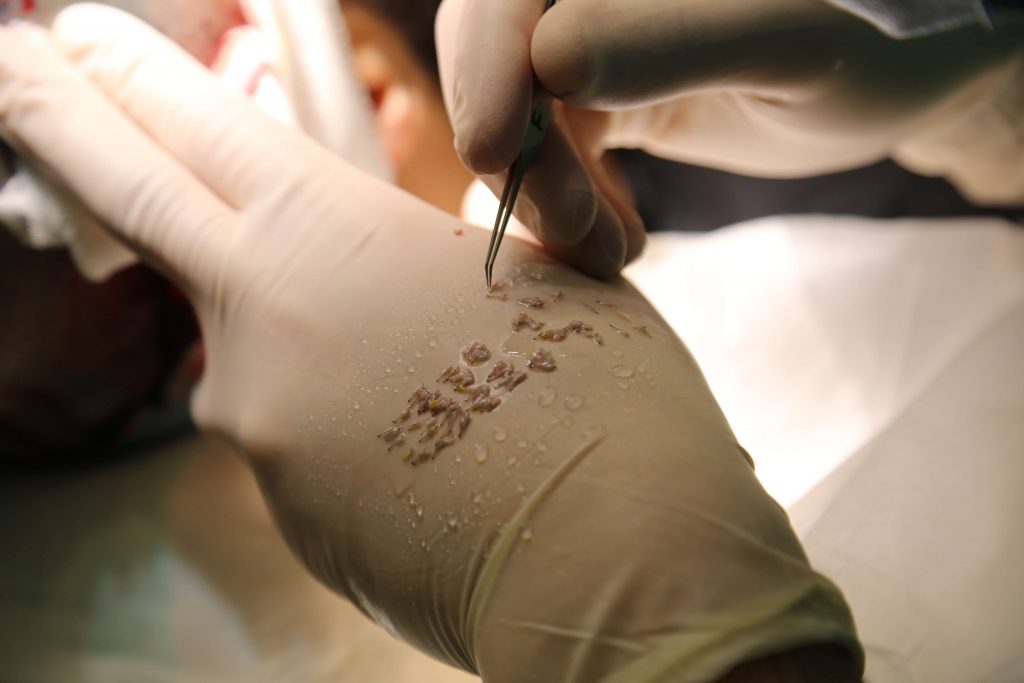As it is a surgery, there are some disadvantages of hair transplant that every patient should be aware of before the procedure. Despite it being safe with a 98% rate of success, here are the long-term and short-term downsides that can inherit during hair implantation :
Short-Term Complications :
1-Bleeding & Swelling Of The Scalp:
It’s the first most common reaction after FUE. The patient can experience temporary swelling of the forehead and temples, typically for less than a week. Besides, decreased sensitivity on top of the head for a few weeks or months after the procedure is possible.
2-Itching:
The second most common and normal side effect of FUE. It is due to the healing process the scalp goes through in order to repair itself following hair extraction and implantation. It is best to avoid scratching otherwise it may result in an infection. If it persists, contact your doctor.
3-Infection or inflammation:
Folliculitis is the term used to describe hair follicle inflammation in response to an infection. The infection can occur in less than 1% of cases. It’s usually, associated with poor hygiene, excessive crust formation, or preexisting medical risk factors. The treatment of folliculitis depends on the underlying cause.
4-Shock Loss:
It is a temporary thinning of the pre-existing hair caused by the micro-trauma of having tiny incisions made between the existing hairs. It can last for a few weeks following the procedure. While the positive impact of the transplanted hairs can be appreciated about six months after the procedure.
5-Crusting:
It’s yet another side effect that a patient shouldn’t worry about because it’s part of the healing process. Crusts help secure the hair grafts and ensure a positive outcome of the procedure. It will disappear after an average of 7–10 days. A first wash is recommended after 48 h to dissolve early crusts. Applying a moisturizer or an emollient is recommended before 30–45 min of washing for softening of crusts. If crusts are still present after postoperative 9–10 days, wet compress or vapor is applied.
Long-Term Complications :
1- Scalp Laxity:
Scalp laxity refers to the ability of the skin to stretch upon the application of force or tension. The stitching in FUE hair transplants limits the flexibility of the scalp oftentimes for a period of 8 months
2- Grafts Which Fail To Take:
A hair transplant failure is incredibly rare, especially if the doctor and patient have discussed pre-and post-operative care. This is why our hair transplant surgeon works with a team of medical professionals that includes nurses and surgical assistants to ensure the success of the procedure.
Other disadvantages :
1- The procedure can take as long as eight hours.
2- Bruising around the eyes
3- Unnatural-looking tufts of hair if not done by a professional
4- Scarring is inevitable after FUE but it’s not noticeable and it can be removed.
How to minimize side effects of hair transplant :
Patients should choose to operate at accredited hospitals. Where the procedure is performed in surgical theaters and follows the aftercare instructions provided by the surgeon to eliminate any complications.
Any patient who is dissatisfied with the outcome of their hair transplant should feel confident that they can still achieve a permanent solution to their thinning hair.
At Espoir Clinic, our surgeons are experienced with hair transplant procedures and we attract clients from all over the world. We would gladly welcome you to fix your unsuccessful transplant or give you free advice!



Leave a Reply